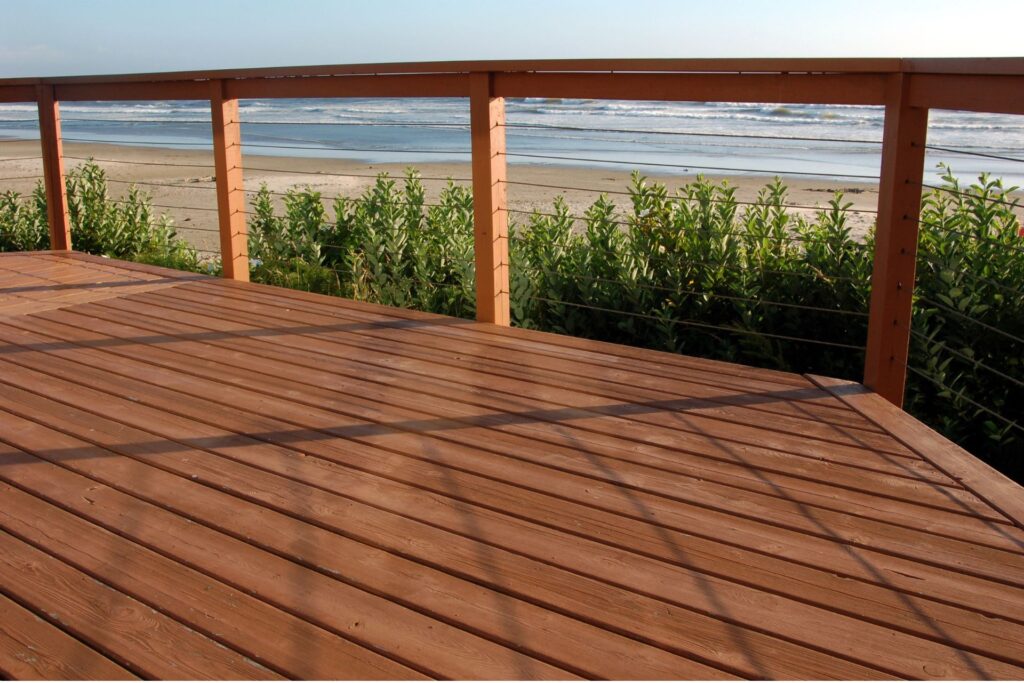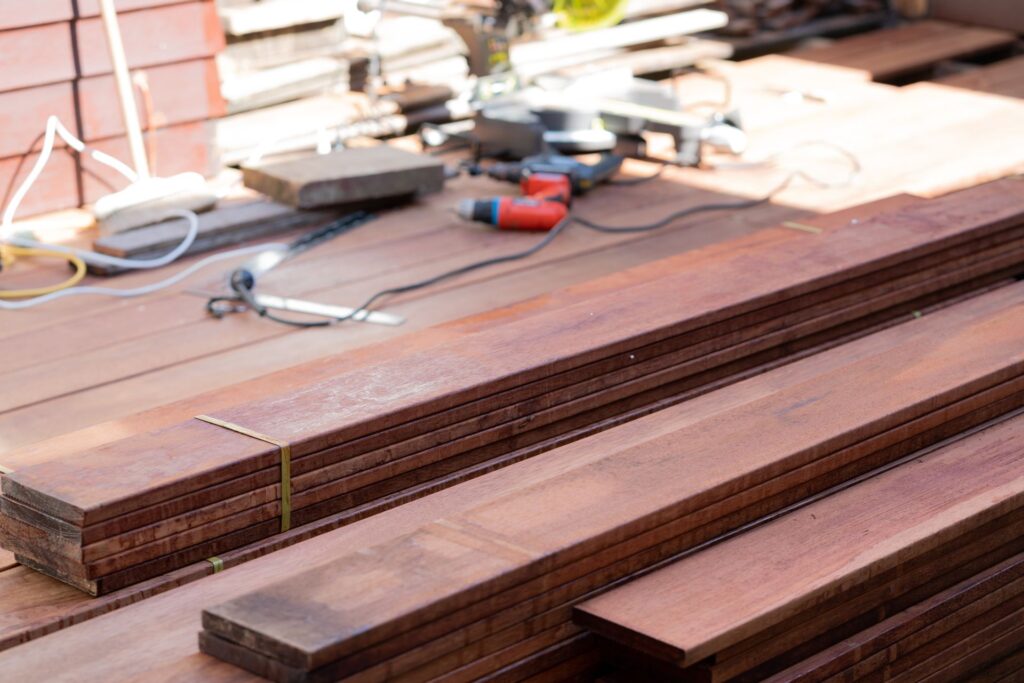Welcome to our comprehensive guide on the various types of decking available in Australia, tailored to enhance your outdoor living space while taking into account our unique climate and lifestyle. Choosing the right decking is crucial not just for the aesthetic appeal of your home but also for adding tangible value to your property. In this post, we’ll dive deep into the world of decking materials, from classic hardwoods that withstand the test of time to innovative, eco-friendly options that promise durability with minimal maintenance. Whether you’re renovating your backyard or building a new deck from scratch, understanding the factors that influence your choice—such as climate adaptability, cost, maintenance levels, and design flexibility—is key. Join us as we explore the pros and cons of each decking type, offering you the insights needed to make an informed decision that suits your budget, preferences, and lifestyle.
Types of decking in Australia cater to diverse tastes and environmental conditions, offering homeowners a range of choices from durable hardwoods like Merbau, Spotted Gum, and Jarrah, which boast longevity and natural beauty, to innovative composite decking made from a blend of wood fibers and recycled plastics for those seeking an eco-friendly, low-maintenance option. PVC and plastic decking present a practical solution for minimal upkeep, resisting moisture and pests effectively, while aluminum decking stands out for its fire resistance and durability, especially in bushfire-prone areas or extreme weather conditions. Balancing factors such as climate adaptability, maintenance requirements, aesthetic desires, and budget considerations is key to selecting the perfect decking material to enhance outdoor living spaces across Australian homes.
Understanding Decking In Australia
Decking in Australia isn’t just about adding an outdoor space; it’s a way of life that blends functionality with the aesthetic charm of Australian homes. The journey of decking materials and styles through the years reflects the evolving Australian lifestyle, showcasing a move from simple, functional spaces to sophisticated outdoor living areas that are as stylish as they are durable. This shift isn’t just a testament to the changing tastes but also to the innovations in materials and construction techniques that have allowed homeowners to embrace the outdoor living culture fully.
Why Decking is a Game-Changer for Australian Homes
The significance of decking in enhancing property value cannot be overstated. A well-designed deck not only extends the living space but also creates a seamless transition between the indoors and the outdoors. It’s a place where memories are made, from summer barbecues to cozy winter gatherings around a fire pit. However, the benefits go beyond just aesthetic appeal and usability. Decking can significantly boost property value, offering an attractive feature to prospective buyers and enhancing the overall appeal of a home. It’s a smart investment that pays dividends in both the short term of enjoyment and the long term of property valuation.
Deciding on the Right Decking for Your Home
When it comes to choosing the perfect decking for your Australian home, several key factors need consideration. Each of these elements plays a crucial role in ensuring that your decking not only looks great but also stands the test of time and the Australian climate.
Climate Considerations: Australia’s diverse climate means decking materials and designs must withstand a range of conditions, from harsh sun exposure and humidity to coastal salt spray. Selecting materials that can endure your local weather conditions is crucial for the longevity of your deck.
Maintenance Requirements: Understanding the maintenance level of different decking materials can help in making an informed decision. While some materials may require regular staining or sealing, others might only need occasional cleaning. Opting for low-maintenance materials can save time and effort in the long run, making your decking experience more enjoyable.
Durability and Lifespan: The durability of your decking is paramount, especially in a country known for its rugged landscape and outdoor lifestyle. Choosing materials known for their longevity can ensure that your deck remains a lasting addition to your home.
Aesthetic Preferences: The look and feel of your deck should reflect your personal style and complement your home’s architecture. With a wide range of materials and finishes available, from natural woods to composite materials, you can select a decking option that enhances your home’s exterior design.
Cost Considerations: Finally, budget plays a significant role in the decision-making process. It’s important to balance cost with quality and long-term value. Investing in high-quality materials and professional installation may have a higher upfront cost but can lead to lower maintenance costs and increased property value over time.
In conclusion, decking in Australia is more than just an outdoor feature; it’s an integral part of the Australian way of life that enhances the beauty and functionality of homes while offering a worthwhile investment in property value. By carefully considering climate, maintenance, durability, aesthetics, and cost, homeowners can select decking that not only meets their needs but also stands as a testament to their style and the enduring appeal of outdoor living in Australia.
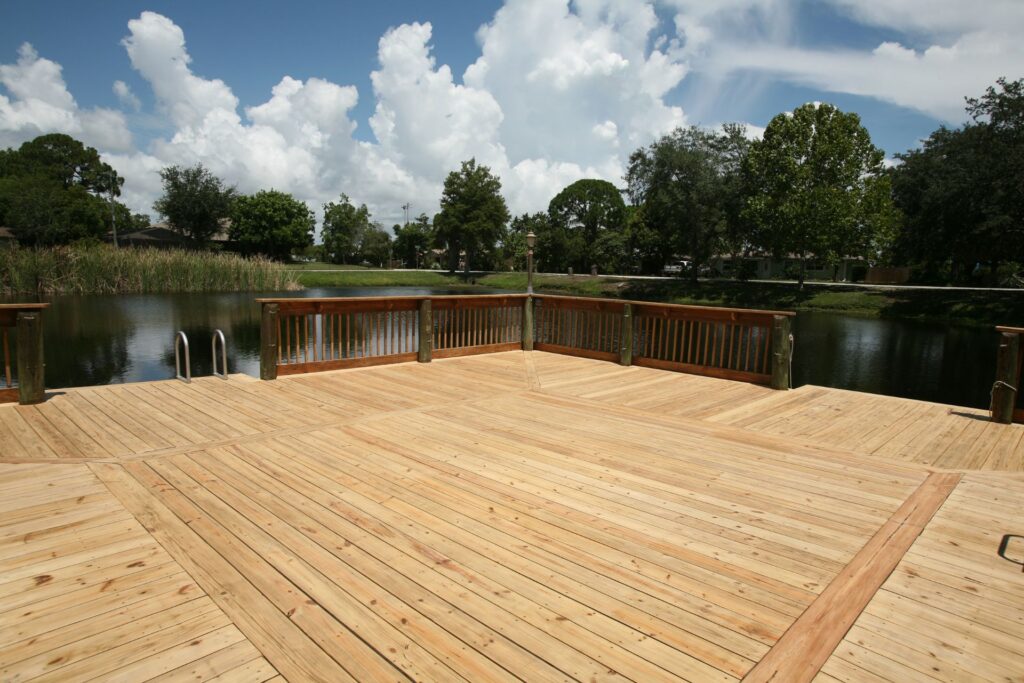
Types Of Decking Materials
Creating an engaging and comprehensive guide to the various types of decking materials available for your outdoor space is essential for homeowners looking to enhance their outdoor living areas. Whether you’re building a new deck or renovating an existing one, understanding the different materials can help you make an informed decision that suits your lifestyle, budget, and aesthetic preferences. Let’s dive into the diverse world of decking materials, covering everything from the natural beauty of timber to the durability of synthetic options.
Timber Decking: A Natural Choice
Timber decking is a popular choice for many homeowners due to its natural beauty and warmth. It can be divided into two main categories: hardwood and softwood.
Hardwood Decking: Choices like Merbau, Spotted Gum, and Jarrah are favorites among those looking for durability and a rich color palette. Hardwoods are known for their longevity and resistance to wear, making them a great option for high-traffic areas. They do require regular maintenance, including oiling and sealing, to preserve their appearance and resistance to the elements.
Softwood Decking: Treated Pine is a cost-effective softwood option that’s treated to resist rot, decay, and termites. While it may not offer the same level of durability or aesthetic appeal as hardwood, treated pine is a great choice for those on a budget. Regular maintenance, including painting or staining, is recommended to extend its life and enhance its look.
Composite Decking: The Low-Maintenance Alternative
Composite decking is made from a blend of wood fibers and recycled plastics, offering a sustainable and low-maintenance alternative to traditional timber. It’s designed to resist fading, staining, scratching, and mold, making it an ideal choice for those looking to minimize upkeep. Composite decking comes in a variety of colors and textures, mimicking the look of natural wood without the need for regular sealing or staining. Key brands available in Australia, such as Trex and ModWood, offer products that combine performance with environmental sustainability.
PVC and Plastic Decking: Eco-Friendly and Durable
PVC and plastic decking are synthetic options known for their durability and resistance to environmental factors like moisture, insects, and decay. These materials require minimal maintenance, with just occasional cleaning needed. They’re also lightweight and easy to install. However, it’s important to consider the environmental impact of these materials, as they are not as easily recycled as composite decking.
Aluminum Decking: The Modern, Durable Choice
Aluminum decking is a premium decking material that stands out for its durability, rust resistance, and minimal maintenance requirements. It’s an excellent choice for areas exposed to extreme weather conditions or for those looking for a modern, sleek appearance. While the initial cost may be higher than other options, its longevity and ease of care can make it a cost-effective choice over time.
When choosing the right decking material for your home, consider factors such as climate, maintenance, budget, and aesthetics. Whether you prefer the natural look of timber, the durability of composite, or the modern appeal of aluminum, there’s a decking material to suit every style and need. By understanding the characteristics, benefits, and maintenance requirements of each type, you can create a beautiful, functional outdoor space that will be enjoyed for years to come.
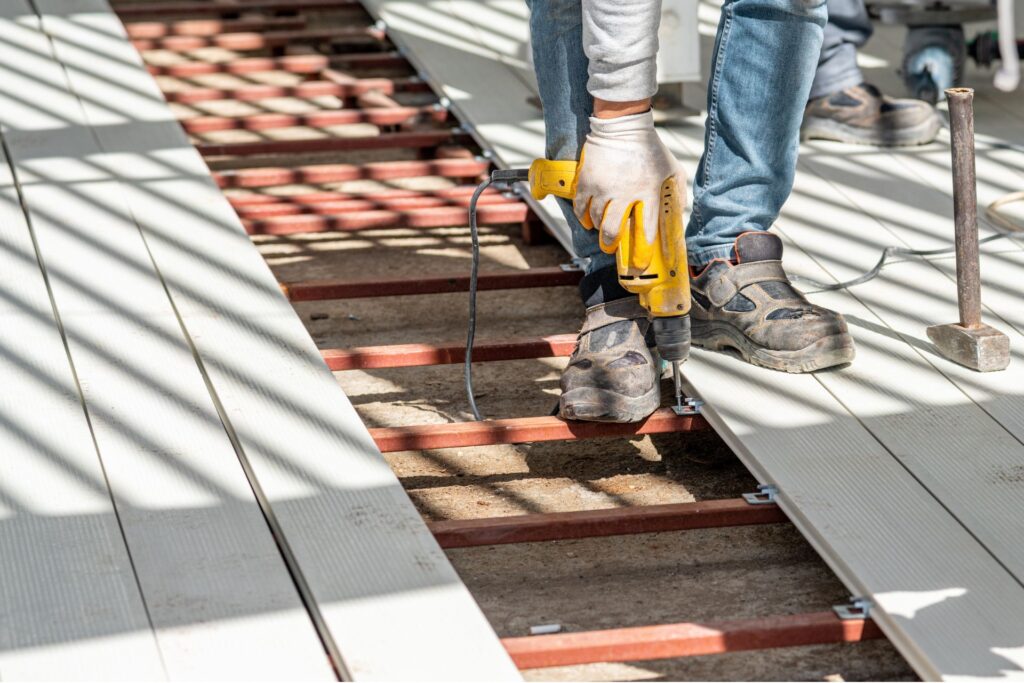
Design And Aesthetic Considerations
In the quest to create an outdoor living space that is not only functional but also a feast for the eyes, homeowners often delve into the art of decking. This section of our comprehensive guide explores the pivotal aspects of design and aesthetic considerations that can transform your decking into a harmonious extension of your home. Let’s embark on this creative journey together.
Style and Colour Choices: Harmonizing with Your Home’s Exterior and Landscape
Choosing the right style and color for your decking is akin to selecting the perfect outfit for an occasion; it needs to reflect your home’s personality while seamlessly blending with its surroundings. The process goes beyond mere personal preference, as it requires a thoughtful consideration of your home’s architectural style and the natural palette of your garden or landscape.
To achieve a cohesive look, start by evaluating the predominant colors and materials of your home’s exterior. A modern, minimalist home may benefit from sleek, composite decking in neutral shades, while a classic, heritage-style home might find its soulmate in rich, wooden tones that echo its historic charm. The goal is to create a visual bridge that unites your home with its outdoor space, making it appear as a single, well-thought-out entity.
Moreover, consider the hues of your landscape. Decking that complements the colors of your garden’s flora or the natural stone elements in your outdoor area can enhance the overall aesthetic appeal. For those looking to add a vibrant touch, integrating colored deck boards or patterned accents can inject personality into your space without overwhelming the senses.
Texture and Finishing Options: Elevating Aesthetics and Safety
The texture and finishing of your decking material play a crucial role in defining its look and functionality. From the rustic charm of wood grains to the sleek finish of composite decking, the options are vast. However, it’s essential to balance aesthetics with practicality, especially concerning safety.
For instance, decks that are frequently wet, either from a pool or climate conditions, should prioritize slip-resistant finishes to prevent accidents. Textured composite or wooden decking with a brushed surface can offer both safety and style. Additionally, the choice of finish can influence the maintenance needs of your decking; some materials may require regular sealing or staining to retain their beauty and resilience against the elements.
Incorporating lighting within your decking can also elevate its aesthetic and safety features. Strategically placed LED lights can accentuate the decking’s texture while ensuring visibility during the evening hours, creating a captivating ambiance that invites relaxation and enjoyment.
Innovative Decking Designs: Inspiration from Australia
Australia, with its diverse landscapes and love for outdoor living, has become a hotbed for innovative decking designs. From sprawling, multi-level decks that offer panoramic views to cozy, sunken lounges that foster intimacy, the creativity is boundless.
One trend gaining traction is the integration of built-in seating and planters, which not only maximizes space but also adds a green, lively touch to the decking area. For those with a penchant for uniqueness, incorporating geometric patterns or mixed materials (like combining wood with glass or metal accents) can set your deck apart.
Another design element popular in Australia is the seamless indoor-outdoor flow. By choosing decking materials and styles that mirror the interior flooring, you can blur the boundaries between inside and outside, enhancing the sense of space and unity in your home.
In conclusion, the journey to selecting the perfect decking involves a delicate balance between style, safety, and functionality. By considering the architectural harmony with your home, prioritizing texture and finishing for both aesthetics and safety, and drawing inspiration from innovative designs, you can create an outdoor space that is not only a testament to your style but also a versatile extension of your living area. Let your decking be a canvas for your creativity and a gateway to countless memories under the open sky.

Installation And Maintenance Tips
In this section, we delve into the crucial aspects of decking installation and maintenance, aiming to assist homeowners in making informed decisions and keeping their outdoor spaces in pristine condition. This section is tailored to ensure your deck not only looks inviting but remains a durable and enjoyable extension of your home. Let’s navigate through the choices between DIY and professional installation, offer maintenance advice tailored to various decking materials, and tackle common decking dilemmas.
DIY vs. Professional Installation: Making the Right Choice
When it comes to installing a new deck, homeowners face the initial decision of whether to embark on a DIY project or enlist the services of a professional. This choice hinges on several factors, including budget constraints, the complexity of the design, and personal handiwork skills.
Pros of DIY Installation
Cost Savings: Perhaps the most compelling reason to consider DIY is the potential for cost reduction, primarily through eliminating labor expenses.
Personal Satisfaction: Completing a deck installation personally can offer a profound sense of achievement and a deeper connection to the space.
Cons of DIY Installation
Time and Effort: A DIY project demands a significant investment of time and physical effort, often extending over several weekends or longer.
Risk of Mistakes: Without professional expertise, there’s a heightened risk of errors, which can lead to additional costs or the need for corrections down the line.
Pros of Professional Installation
Expertise and Efficiency: Professionals bring a wealth of experience, ensuring the project is completed swiftly and correctly.
Warranty and Reliability: Many professionals offer warranties on their work, providing peace of mind regarding the longevity and durability of the installation.
Cons of Professional Installation
Cost: The primary drawback of professional installation is the higher upfront cost, mainly attributed to labor charges.
Maintenance Guide for Each Decking Type
Different decking materials require unique maintenance approaches to retain their appearance and integrity over time. Here’s a quick rundown:
Wood Decking: Regular cleaning, annual sealing, and periodic staining or painting are vital to prevent water damage and fading. Inspect for splinters or signs of rot and address promptly.
Composite Decking: Though low-maintenance, composite decks benefit from semi-annual cleaning with soap and water to prevent mold growth and staining.
Vinyl (PVC) Decking: Vinyl decking is the easiest to maintain, requiring only occasional washing to keep it looking new. However, it’s susceptible to scratches and cuts, which should be avoided.
Common Issues and Solutions
Deck ownership is not without its challenges. Here are solutions to some frequent problems:
Fading: Exposure to sunlight can cause decking materials to fade. For wood decks, a fresh stain or sealant can revitalize the appearance. Composite and vinyl decking materials, designed to be fade-resistant, might need replacement of the affected boards.
Warping: Often a result of moisture imbalance, warping is best combated by ensuring proper installation and maintenance, particularly sealing wood decks.
Pest Infestation: Regular inspections can catch early signs of pest damage. For wooden decks, using treated wood and applying appropriate sealants can deter pests.
By choosing the right installation approach and adhering to material-specific maintenance routines, homeowners can enjoy a beautiful, long-lasting deck. Addressing common issues promptly can prevent minor problems from escalating, ensuring your deck remains a cherished part of your home for years to come. Remember, a well-maintained deck not only enhances the beauty and functionality of your outdoor space but also contributes to the overall value of your property.

Sustainability And Environmental Considerations
In today’s environmentally conscious world, the importance of sustainability and eco-friendly practices cannot be overstated, especially in construction and home improvement projects. This section dives deep into how these principles apply to decking options, offering invaluable insights for homeowners, builders, and anyone looking to make a positive impact on the planet while enjoying beautiful outdoor spaces.
Eco-friendly Decking Options
When it comes to choosing materials for your deck, the sustainability of those materials plays a critical role not only in the environmental impact of your project but also in its longevity and maintenance requirements. Eco-friendly decking options have come a long way, offering a variety of choices that are both aesthetically pleasing and kind to the planet.
Materials like composite decking, made from recycled plastic and wood fibers, have become increasingly popular due to their durability and minimal maintenance needs. Unlike traditional wood decking, composite materials do not require the same level of upkeep, such as staining and sealing, making them a more sustainable choice over time. Moreover, the use of recycled materials in their production helps reduce waste and conserves natural resources.
Bamboo decking is another sustainable option that has gained attention. Bamboo, known for its rapid growth and regenerative abilities, is a highly renewable resource. It offers a distinct and elegant aesthetic while providing strength and durability comparable to traditional wood decking.
When considering eco-friendly decking materials, it’s essential to look at the full lifecycle of the products, including their manufacturing processes, longevity, and eventual disposal. Opting for materials that are sustainably sourced and manufactured, as well as durable and recyclable, can significantly reduce the environmental footprint of your decking project.
Recycling and Disposal
Proper disposal and recycling of old decking material are paramount to minimizing the environmental impact of your renovation or construction project. As decks come to the end of their life, it’s important to consider the most responsible ways to dispose of or recycle the materials.
For wood decking, consider repurposing the material for other projects, such as outdoor furniture or garden structures. If repurposing is not an option, check with local recycling centers to see if the wood can be recycled. It’s crucial, however, to ensure that the wood is free of any treatments or chemicals that might make it unsuitable for recycling.
Composite decking, which often contains plastics, can also be recycled at facilities that accept mixed materials. Contacting the manufacturer for recycling programs or guidance can be a good first step, as some companies offer take-back programs for their products.
Disposing of decking materials in an environmentally friendly way requires a bit of research and effort but is a critical step in reducing waste and conserving resources. Always look for recycling options before considering the landfill, and seek out local waste management resources for guidance on how to dispose of materials responsibly.
In conclusion, incorporating sustainability and environmental considerations into your decking project is not only beneficial for the planet but can also enhance the value and enjoyment of your outdoor space. By choosing eco-friendly materials and adhering to best practices for recycling and disposal, you can create a beautiful, durable deck that aligns with your environmental values.
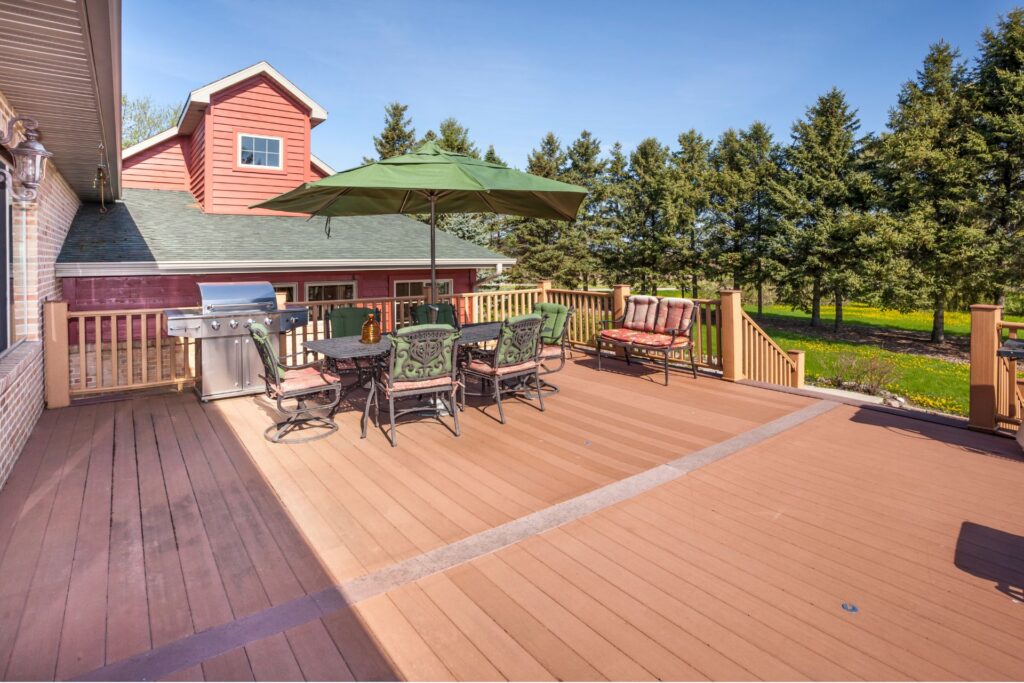
Cost Analysis And Budget Planning
In crafting a guide for your decking project, our goal is to present valuable insights that can help homeowners make informed financial decisions. This guide aims to balance quality with affordability, providing practical advice on navigating price comparisons among different materials and budgeting effectively for your project.
Price Comparison Among Different Materials: Initial Costs vs. Long-term Savings
When planning a decking project, one of the first considerations is the choice of material. The market offers a variety of options, each with its own set of benefits and drawbacks. Understanding the initial costs versus long-term savings is crucial in making an informed decision that aligns with both your immediate budget and future maintenance considerations.
Initial Costs: The upfront price of decking materials can vary widely. Hardwood options like teak or ipe are known for their durability and longevity but come at a higher initial cost. On the other hand, pressure-treated lumber offers a more budget-friendly upfront expense but may require more maintenance over time. Composite decking, while higher in initial investment than some woods, offers a middle ground with less maintenance and a long lifespan.
Long-term Savings: It’s essential to consider the longevity and maintenance requirements of your chosen material. While some materials may have a higher upfront cost, their durability and low maintenance can lead to significant savings over time. For example, composite decking requires little more than regular cleaning, avoiding the costs of staining, sealing, or replacing boards that you might face with wood options.
Budgeting for Your Decking Project: Tips on Saving Money Without Compromising Quality
Effective budgeting is key to executing a decking project that meets both your aesthetic and financial goals. Here are several tips to help you save money without sacrificing quality:
1. Detailed Planning: Begin with a clear plan of your decking project. Understanding the scope and specifications can help you avoid unexpected costs and ensure you’re comparing materials and labor accurately.
2. Get Multiple Quotes: Don’t settle on the first quote you receive. Instead, solicit bids from multiple contractors to ensure you’re getting a competitive price for the work.
3. Consider the Off-Season: Scheduling your project during the off-peak seasons (late fall or early winter) can lead to lower prices on both materials and labor as demand decreases.
4. DIY What You Can: Evaluate which aspects of the project you can safely and effectively handle yourself. Tasks like the demolition of an old deck or the finishing touches can save you on labor costs.
5. Look for Deals on Materials: Keep an eye out for sales at local hardware stores or consider buying surplus materials from other projects at a discount.
6. Prioritize Spending: Identify where it’s worth investing in quality (like the decking material itself) and where you can opt for more cost-effective solutions without compromising the project’s overall integrity.
By applying these principles of cost analysis and budget planning, you can navigate the complexities of selecting the right materials and managing your decking project’s finances effectively. Not only will this approach help you save money in the short term, but it will also ensure that your deck remains a valuable, enjoyable, and durable extension of your living space for years to come.

FAQs: About Types Of Decking In Australia
Conclusion
Selecting the ideal decking for Australian homes is a nuanced decision that significantly impacts the functionality, aesthetic appeal, and overall value of your outdoor living space. Considering Australia’s diverse climate, it’s crucial to choose materials that not only withstand the elements but also align with your lifestyle, budget, and design preferences. Whether your deck serves as a bustling hub for family gatherings or a tranquil retreat for relaxation, selecting a material that is durable, easy to maintain, and aesthetically pleasing is key. Balancing the initial investment against long-term maintenance and the potential to enhance your property’s value is essential. Ultimately, the right decking choice should not only complement your home’s architecture and style but also reflect your taste, ensuring that your outdoor space becomes a cherished extension of your home. This holistic approach to choosing decking ensures that your deck is not just a functional outdoor area but a strategic enhancement to your home’s appeal and a haven for making memories.
Find A Deck Builder Near You
About the Author:
Mike Veail is a recognized digital marketing expert with over 6 years of experience in helping tradespeople and small businesses thrive online. A former quantity surveyor, Mike combines deep industry knowledge with hands-on expertise in SEO and Google Ads. His marketing strategies are tailored to the specific needs of the trades sector, helping businesses increase visibility and generate more leads through proven, ethical methods.
Mike has successfully partnered with numerous companies, establishing a track record of delivering measurable results. His work has been featured across various platforms that showcase his expertise in lead generation and online marketing for the trades sector.
Learn more about Mike's experience and services at https://theleadguy.online or follow him on social media:

